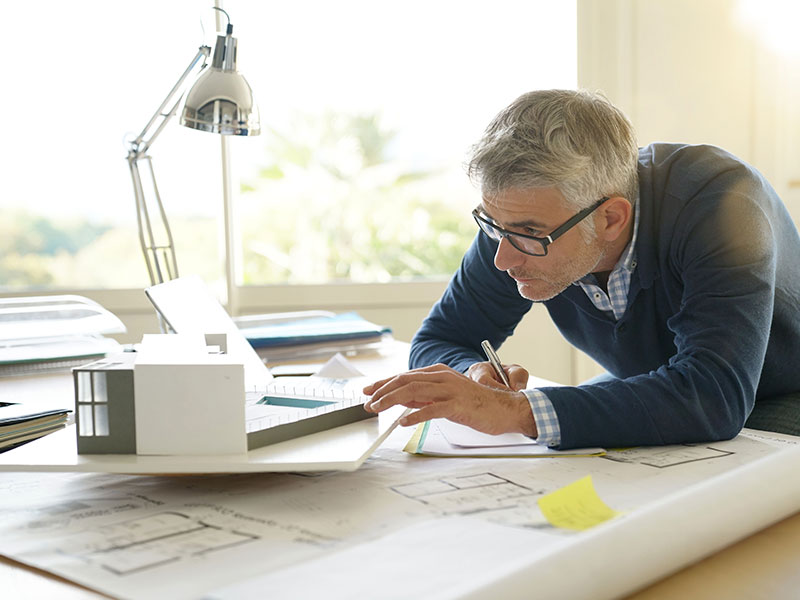Architect Design Movements to Track in the Coming Year
Architect Design Movements to Track in the Coming Year
Blog Article
Comprehending the Diverse Career Paths Available for Aspiring Architect
As an aspiring Architect, you have a globe of job paths awaiting you. Each path uses distinct challenges and chances to use your creativity and technological knowledge. Whether you're attracted to typical style or the nuances of lasting design, there's a specific niche that lines up with your passions. Understanding these varied choices can shape your expert journey, however which direction will you select to discover first?
Traditional Design: Creating Frameworks and buildings
Typical design concentrates on developing buildings and frameworks that mix capability with aesthetic charm. Your styles can show social heritage, showcasing regional customs while fulfilling modern demands.
You'll develop abilities in composing, model-making, and site analysis, enabling you to visualize and communicate your concepts efficiently. Involving with customers, you'll need to understand their vision and convert it right into possible layouts.
Furthermore, building codes and sustainability methods are vital in your work, guaranteeing your frameworks are secure and eco friendly. As you grow in your profession, you'll discover chances in property, business, and even repair tasks, each offering special difficulties. Welcoming standard design leads the way for a satisfying profession that pays homage to the past while shaping the future.
Urban Planning: Shaping Neighborhoods and Public Spaces
As a hopeful Architect, you can play a vital function as a city planner, transforming exactly how communities connect and work. By using area engagement strategies, you'll guarantee that locals have a voice fit their setting. And also, integrating lasting style principles will aid produce areas that not only satisfy today's requirements however also protect the future.
Function of Urban Planners
While numerous may think about engineers as the single visionaries behind structures, urban planners play a vital duty fit the wider landscape of areas and public spaces. They examine land usage, zoning regulations, and neighborhood requires to create sustainable environments that improve lifestyle. By working together with numerous stakeholders, you'll aid make parks, transport systems, and property locations that advertise social communication and ease of access. Urban planners also focus on ecological considerations, making sure that advancements incorporate environment-friendly spaces and support biodiversity. Your proficiency in spatial style and neighborhood characteristics enables you to envision future growth while preserving cultural heritage. In this critical duty, you'll directly influence exactly how individuals experience their surroundings, making every job a chance for positive adjustment.
Community Engagement Methods
Efficient neighborhood engagement strategies are vital for urban organizers to assure that the voices of citizens are listened to and valued in the planning procedure. To promote significant discussion, you ought to prioritize open discussion forums and workshops where neighborhood members can reveal their ideas and problems. By proactively including and listening feedback, you'll create rooms that mirror the neighborhood's requirements, ultimately leading to even more lasting and effective metropolitan atmospheres.
Lasting Style Principles
When designing urban rooms, integrating sustainable design concepts is essential for developing settings that thrive both environmentally and socially. You ought to begin by concentrating on energy efficiency, making use of products that decrease waste and advertise recycling. Consider incorporating environment-friendly rooms, like yards and parks, to improve biodiversity and boost air top quality. Promoting walkability and public transport can lessen reliance on automobiles, fostering a healthier community.
Creating with water preservation in mind is likewise key-- think of rain yards and absorptive surface areas to handle stormwater. Involving area participants during the planning procedure guarantees that the areas you develop fulfill their requirements and encourage social communication. By accepting these concepts, you'll add to dynamic, sustainable urban landscapes that profit everyone.

Landscape Design: Producing Lasting Outside Atmospheres
As you explore landscape architecture, you'll discover crucial style concepts that produce useful and attractive exterior areas. Sustainable techniques play a crucial role in making certain these environments flourish while decreasing ecological impact. Plus, you'll discover a range of occupation possibilities that enable you to make a genuine distinction in just how individuals interact with nature.
Design Concepts in Landscape
Comprehending layout concepts in landscape design is vital for creating sustainable outside settings that balance with nature. You'll need to consider components like scale, balance, and proportion to assure your layouts feel natural and welcoming. Furthermore, pay interest to seasonal adjustments, developing with products that enhance the environments year-round.
Sustainable Practices Summary
Sustainable practices in landscape architecture not just concentrate on aesthetics yet likewise prioritize ecological health and wellness and source preservation. By integrating native plants, you boost biodiversity and reduce the demand for chemical plant foods and pesticides. Applying effective irrigation systems helps conserve water and lessens overflow, securing nearby environments. You can create areas that promote soil wellness, such as making use of natural materials and practicing permaculture principles. Additionally, incorporating environment-friendly infrastructure, like rain yards and permeable pavements, aids in stormwater administration and reduces metropolitan heat. When you develop outside settings with sustainability in mind, you contribute to a much healthier world and give areas that promote neighborhood link. Inevitably, these techniques assure your styles benefit both people and the atmosphere for many years to come.
Job Opportunities Expedition
With a strong structure in lasting practices, landscape architecture supplies a variety of job courses that permit you to make a meaningful impact on the environment. Urban planners usually collaborate with landscape designers to create eco-friendly spaces in city setups, boosting city livability. If you're enthusiastic about education, think about ending up being a landscape style instructor, inspiring future generations.
Lasting Design: Concentrating on Eco-Friendly Practices
As you explore your job in design, accepting eco-friendly methods can set you apart in a competitive area. Sustainable style concentrates on creating buildings that decrease ecological influence while improving owner health. By integrating sustainable products, energy-efficient systems, and sustainable structure techniques, you'll add to a greener future.
Begin by getting understanding of this content environment-friendly accreditations like LEED or BREEAM, which can bolster your credentials. Take into consideration just how natural light, air flow, and thermal efficiency can enhance style. Work together with designers and environmental professionals to introduce solutions that minimize waste and save sources.
Don't forget the importance of neighborhood participation-- interesting local stakeholders can influence designs that integrate with the environment. As clients significantly prioritize sustainability, your knowledge in eco-friendly techniques will certainly not just draw in projects but additionally accomplish your interest for accountable architecture. Embrace this critical facet of the career, and view your occupation thrive.
Historical Preservation: Securing and Restoring Social Heritage
While you start on your architectural journey, take into consideration the crucial duty of historical preservation in maintaining our social heritage. This area concentrates on the protection and repair of considerable structures, websites, and frameworks that tell the stories of our past. By involving in historical conservation, you'll aid protect the building heritage that shapes community identity.
As a historical preservation Architect, you'll analyze historic value and assess the condition of frameworks. You'll work closely with historians and conservationists to guarantee genuine repair techniques are used. This you could look here occupation course allows you to blend imagination with research study, enabling you to develop options that respect initial products and workmanship.
Your work not just adds to sustainability by recycling existing buildings yet likewise cultivates a feeling of satisfaction within areas. Accepting this course will help you become a guardian of background, maintaining the tales and aesthetics that enhance our lives.
Inside Style: Enhancing Indoor Spaces
Historic preservation and interior architecture both share a commitment to boosting the constructed atmosphere, however they concentrate on different facets. While historical preservation emphasizes preserving a structure's historical and cultural value, indoor design nos in on maximizing indoor spaces for capability and appearances.
As an aspiring Architect, you'll find that interior design enables you to mix creativity with technical skills. You'll develop areas that not only look great yet additionally advertise convenience and performance. This area involves understanding how light, color, and materials communicate within a space, affecting state of mind and functionality.
You'll work with different jobs, from property homes to industrial workplaces, making sure that each setting satisfies the requirements of its passengers. By prioritizing individual experience, you can transform interiors into inspiring and practical spaces, making a considerable effect on exactly how people this interact with their environments. Accept the chance to enhance indoor settings and shape the way people function and live.
Industrial Style: Combining Capability With Aesthetic Appeals
Commercial design plays a vital role in developing items that perfectly blend aesthetics with capability, making sure that what you utilize daily is not just visually appealing however also sensible. As a hopeful Architect, you could engage yourself in this area, focusing on making everything from furniture to customer electronics. Your job includes recognizing individual needs, products, and manufacturing procedures, allowing you to develop innovative options that enhance day-to-day experiences.
In industrial style, you'll typically team up with marketing experts, designers, and producers, guaranteeing that your designs are not only beautiful but also possible. This profession path offers a vibrant atmosphere where imagination meets practicality, making it a fulfilling option for designers interested in forming the items of tomorrow.
Regularly Asked Concerns
What Educational Credentials Do I Required to End Up Being an Architect?
To end up being a designer, you'll need a specialist degree in architecture, commonly a Bachelor's or Master's. In addition, you'll have to complete a teaching fellowship and pass the Architect Enrollment Evaluation to practice legitimately.
Are There Certification Demands for Different Building Career Paths?
Yes, there're qualification demands for various building paths. Architect. You'll require to pass exams, total internships, and occasionally go after specialized training, relying on your selected emphasis, like landscape architecture, city style, or historical preservation
What Software Program Skills Are Necessary for Architects Today?

How Can I Gain Practical Experience While Studying Architecture?
You can gain sensible experience by interning at architectural companies, joining style competitions, offering for community tasks, or working together with schoolmates on real-world tasks. These possibilities improve your abilities and develop beneficial connections in the sector.
What Task Opportunities Exist Outdoors Standard Style Firms?
You can check out numerous job chances outside traditional design companies, like city planning, interior decoration, landscape architecture, building and construction administration, property growth, and even duties in sustainability consulting. Each offers distinct difficulties and benefits.
Whether you're attracted to standard architecture or the nuances of lasting style, there's a specific niche that straightens with your rate of interests.When creating city spaces, integrating lasting layout principles is crucial for developing atmospheres that prosper both environmentally and socially.As you explore landscape architecture, you'll discover necessary layout principles that produce attractive and functional outside areas.Understanding design principles in landscape architecture is vital for producing sustainable outside settings that integrate with nature.In commercial layout, you'll often collaborate with designers, makers, and marketing experts, ensuring that your designs are not just attractive yet likewise possible.
Report this page